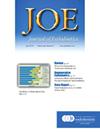激光激活与声波激活灌洗在保守根管中清除碎片的疗效比较。
IF 3.5
2区 医学
Q1 DENTISTRY, ORAL SURGERY & MEDICINE
引用次数: 0
摘要
前言:应用微计算机断层扫描(micro-CT)分析比较激光激活和声波激活灌洗对下颌磨牙近中根管系统碎片清除的效果。方法:选择48颗带峡部的下颌磨牙近中根,随机分为超声组和激光组。对根管进行最小矫治,最大根尖锉大小为20/06v (DCTaper, SSWhite, NJ)。Sonic组使用15/02尖端的SmartLite Pro EndoActivator (Dentsply Tulsa, OK)进行冲洗激活。激光组使用带有RFT2尖端的WaterLase iPlus (Biolase, CA)进行灌溉激活。用相同体积的冲洗液激活牙齿的时间相同。Micro-CT扫描分别在仪器测量前、冲洗前和冲洗后进行。为了量化碎片清除,在灌前和灌后分别测量充气量,并计算充气量增加的百分比。数据进行统计学分析(独立样本t检验,显著性设为5%)。结果:与Sonic组(20.2%)相比,Laser组(37.4%)的充气体积平均百分比增加明显更高。差异有统计学意义(p < 0.05)。结论:在微创根管系统中,激光组比超声组更有效地清除碎片。然而,由于本研究的局限性,需要进一步的研究来评估激光激活灌洗对临床结果的影响。本文章由计算机程序翻译,如有差异,请以英文原文为准。
Efficacy of Laser Activated versus Sonic Activated Irrigation for Debris Removal in Conservatively Instrumented Root Canals
Introduction
To compare the efficacy of laser activated and sonic activated irrigation on the removal of debris in mesial root canal systems of mandibular molars using micro-computed tomographic analysis.
Methods
Forty-eight mesial roots of extracted mandibular molars with isthmus were selected and randomly allocated into 2 groups: Sonic Group and Laser Group. The root canals were minimally instrumented to a maximum apical file size of 20/06v (DCTaper, SSWhite, NJ). The Sonic Group received irrigant activation using the SmartLite Pro EndoActivator (Dentsply Tulsa, OK) with a 15/02 tip. The Laser Group received irrigant activation using the WaterLase iPlus (Biolase, CA) with a RFT2 tip. The teeth were activated for the same time with the same volume of irrigants. Micro-computed tomographic scans were obtained preinstrumentation, preirrigation, and postirrigation. To quantify debris removal, the air-filled volume was measured preirrigation and postirrigation, and the percentage increase in air-filled volume was calculated. Data were analyzed statistically (independent samples t-test, significance set at 5%).
Results
The Laser Group demonstrated a significantly higher mean percentage increase in air-filled volume (37.4%) compared to the Sonic Group (20.2%). This difference was statistically significant (P < .05).
Conclusions
The Laser Group was significantly more effective in removing debris compared to the Sonic Group in minimally instrumented root canal systems. However, due to the limitations of this study, further research is needed to assess the impact of laser activated irrigation on clinical outcomes.
求助全文
通过发布文献求助,成功后即可免费获取论文全文。
去求助
来源期刊

Journal of endodontics
医学-牙科与口腔外科
CiteScore
8.80
自引率
9.50%
发文量
224
审稿时长
42 days
期刊介绍:
The Journal of Endodontics, the official journal of the American Association of Endodontists, publishes scientific articles, case reports and comparison studies evaluating materials and methods of pulp conservation and endodontic treatment. Endodontists and general dentists can learn about new concepts in root canal treatment and the latest advances in techniques and instrumentation in the one journal that helps them keep pace with rapid changes in this field.
 求助内容:
求助内容: 应助结果提醒方式:
应助结果提醒方式:


